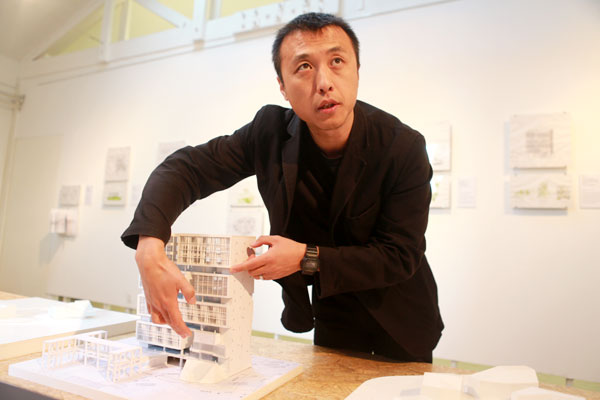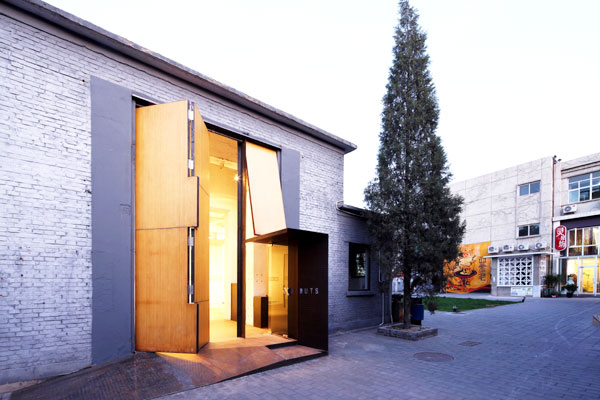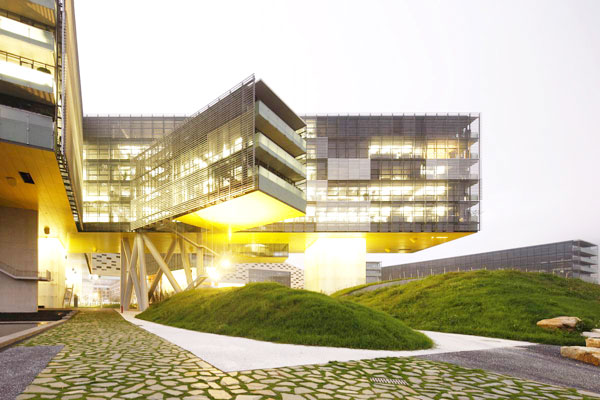
 'Taken 2' grabs movie box office crown
'Taken 2' grabs movie box office crown
 Rihanna's 'Diamonds' tops UK pop chart
Rihanna's 'Diamonds' tops UK pop chart
 Fans get look at vintage Rolling Stones
Fans get look at vintage Rolling Stones
 Celebrities attend Power of Women event
Celebrities attend Power of Women event
 Ang Lee breaks 'every rule' to make unlikely new Life of Pi film
Ang Lee breaks 'every rule' to make unlikely new Life of Pi film
 Rihanna almost thrown out of nightclub
Rihanna almost thrown out of nightclub
 'Dark Knight' wins weekend box office
'Dark Knight' wins weekend box office
 'Total Recall' stars gather in Beverly Hills
'Total Recall' stars gather in Beverly Hills
A skyline all their own
Updated: 2012-11-20 10:50
By Chen Nan (China Daily)
|
||||||||
 |
|
Li Hu displays a model of the Deep Ocean Research Base, one of Open Architecture's projects, at Studio-X Beijing. Feng Yongbin / China Daily |
 |
|
Li wishes to create a nonprofit think-tank via the establishment of Studio-X Beijing, of which he has been the director since 2009. Provided to China Daily |
 |
|
Li Hu was responsible for the design of Steven Holl Architects' several award-winning projects in Asia, such as Vanke Center in Shenzhen, Guangdong province. Provided to China Daily |
A new breed of Chinese architects like Li Hu seeks inspiration from inside themselves. Chen Nan reports.
Conventional wisdom says that "futuristic", modern and massive architecture is making Beijing into an international metropolis. However, Chinese architect Li Hu says the capital city needs architects who have their own attitudes.
"Many Chinese architects struggle with the question of, 'What is Chinese architecture?' 'What is the function of building today?'" says Li. "Today Beijing is built on an inhuman scale. There's no street, no sense of urban space. I am interested in creating space that can really make people comfortable and happy."
A graduate of Tsinghua University in Beijing and Rice University in Houston, Li firmly believes that architects should stick to their own visions while discovering and thinking.
"It's not about following. Following these days is too easy in Chinese architecture, and everything can be copied," he adds.
This feeling brought him back to his home country from the United States. He had joined Steven Holl Architects in 2000 and became a partner in 2005. Running the firm's Beijing office from 2006-2010, he was responsible for the design of the firm's award-winning projects in Asia, including the Linked Hybird in Beijing, Vanke Center in Shenzhen, Guangdong province and Sifang Art Museum in Nanjing, Jiangsu province.
On a recent sunny afternoon, the 37-year-old architect, who earlier spent seven years in New York and returned to Beijing in 2006, unveiled an exhibition by Open Architecture, an experimental design and research studio based in Beijing, which he co-founded with his architect wife Huang Wenjing in 2002.
The studio's 16 projects display the couple's goal to forge new architectural practices, which can address specific contemporary challenges - such as the population density of Beijing - while simultaneously promoting public enjoyment and preserving the environment.
The exhibition lasts until Nov 23, and it's the first of a series of exhibitions titled X Agenda, which was initiated and supported by Studio-X Beijing.
Launched by Columbia University's Graduate School of Architecture, Planning and Preservation, Studio-X was created to build a space for sharing ideas and serious research, an ambitious initiative of a larger global network, which also includes units in New York, Amman and Mumbai.
As the director of Studio-X Beijing since 2009, Li organizes workshops, films and art exhibitions to create a "think-tank" environment designed to engage architectural, urban and cultural issues. He also teaches at Columbia University and Hong Kong University as a visiting professor.
"I want to cultivate a kind of collective architectural thinking and debate that is urgently needed in China today," Li says. "I hope to create a nonprofit think-tank to help the government regarding micro and macro architectural issues related to the future of the city."
Columbia's architecture dean and the mastermind of Studio-X, Mark Wigley, says Li was appointed as director because "he is a leader of a new generation of Chinese designers. He has made Studio-X Beijing a real home for creativity and collegiality".
The ongoing exhibition is housed in a renovated factory building inside a courtyard of the capital's Fangjia Hutong, which is also a project of Open Architecture.
Li started the exhibition series by introducing his own works. The 6-meter-tall building was formerly used as a munitions factory during the War of Resistance against Japanese Aggression (1937-45). The architect knocked down the walls inside the building and opened nine windows in the ceiling. Wheels have been added to the furniture, which makes the space flexible and changeable.
The space will showcase a number of young rising Chinese architects in exhibitions during the coming year.
Past events at Studio-X include Beijing Rediscover, an exhibition that explored contemporary Beijing, organized in conjunction with the Goethe Institute, and a show of contemporary ink-and-water paintings by artists from Beijing and New York.
Wigley notes that experts predict that by 2050, about 70 percent of the world's 9.3 billion people will be living in cities.
"China has always been one of the most important centers of architectural tradition and creativity. For thousands of years, it has been a model. Now it is a global model again but a model of radical change," he says in an e-mail interview with China Daily.
"Wonderful projects are being built but also terrible ones. The point is that in all this change, new understandings, new concepts, new techniques will be born and some of this new thinking will become very influential to the rest of the world."
In the past, major global universities would open research centers in other countries simply to distribute their sophisticated knowledge around the world. Wigley's thinking behind Studio-X is to have open research centers so that the latest thinking can flow in both directions.
Wigley says China's new generation of architects draws on the best thinking from around the world, "but their real strength is that they actively participate in the major transformations going on in China".
"They are re-inventing what architectural practice can be for a new world. They were our students but now they become our teachers. This is the main point of Studio-X - to listen and learn from a new generation," he says.
Contact the writer at chennan@chinadaily.com.cn.
Most Viewed
Editor's Picks

|

|

|

|

|

|
Today's Top News
Health new priority for quake zone
Xi meets US top military officer
Japan's boats driven out of Diaoyu
China mulls online shopping legislation
Bird flu death toll rises to 22
Putin appoints new ambassador to China
Japanese ships blocked from Diaoyu Islands
Inspired by Guan, more Chinese pick up golf
US Weekly

|

|







